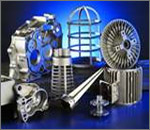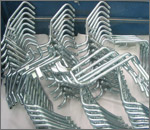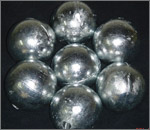Zinc, also known as spelter, is a metallic chemical element; it has the symbol Zn and atomic number 30. It is the first element in group 12 of the periodic table. Zinc is, in some re

spects, chemically similar to magnesium, because its ion is of similar size and its only common oxidation state is +2. Zinc is the 24th most abundant element in the Earth's crust and has five stable isotopes. The most exploited zinc ore is sphalerite, a zinc sulfide. The largest exploitable deposits are found in Australia, Canada, and the United States. Zinc production includes froth flotation of the ore, roasting, and final extraction using electricity (electrowinning).
Brass, which is an alloy of copper and zinc, has been used since at least the 10th century BC. Impure zinc metal was not produced in large scale until the 13th century in India, while the metal was unknown to Europe until the end of the 16th century. Alchemists burned zinc in air to form what they called "philosopher's wool" or "white snow". The element was probably named by the alchemist Paracelsus after the German word Zinke. German chemist Andreas Sigismund Marggraf is normally given credit for discovering pure metallic zinc in 1746. Work by Luigi Galvani and Alessandro Volta uncovered the electrochemical properties of zinc by 1800. Corrosion-resistant zinc plating of steel (hot-dip galvanizing) is the major application for zinc. Other applications are in batteries and alloys, such as brass. A variety of zinc compounds are commonly used, such as zinc carbonate and zinc gluconate (as dietary supplements), zinc chloride (in deodorants), zinc pyrithione (anti-dandruff shampoos), zinc sulfide (in luminescent paints), and zinc methyl or zinc diethyl in the organic laboratory.
Zinc is an essential mineral of "exceptional biologic and public health importance". Zinc deficiency affects about two billion people in the developing world and is associated with m

any diseases. In children it causes growth retardation, delayed sexual maturation, infection susceptibility, and diarrhea, contributing to the death of about 800,000 children worldwide per year. Enzymes with a zinc atom in the reactive center are widespread in biochemistry, such as alcohol dehydrogenase in humans. Consumption of excess zinc can cause ataxia, lethargy and copper deficiency.
Various isolated examples of the use of impure zinc in ancient times have been discovered. A possibly prehistoric statuette containing 87.5% zinc was found in a Dacian archaeological site in Transylvania (modern Romania). Ornaments made of alloys that contain 80–90% zinc with lead, iron, antimony, and other metals making up the remainder, have been found that are 2500 years old. The Berne zinc tablet is a votive plaque dating to Roman Gaul made of an alloy that is mostly zinc. Also, some ancient writings appear to mention zinc. The Greek historian Strabo, in a passage taken from an earlier writer of the 4th century BC, mentions "drops of false silver", which when mixed with copper make brass. This may refer to small quantities of zinc produced as a by-product of smelting sulfide ores. The Charaka Samhita, thought to have been written in 500 BC or before, mentions a metal which, when oxidized, produces pushpanjan, thought to be zinc oxide.
Zinc ores were used to make the zinc–copper alloy brass many centuries prior to the discovery of zinc as a separate element. Palestinian brass from the 14th to 10th centuries BC contains 23% zinc. The Book of Genesis, written between the 10th and 5th centuries BC, mentions Tubalcain as an "instructor in every artificer in brass and iron" (Genesis 4:22). Knowledge of how to produce brass spread to Ancient Greece by the 7th century BC but few varieties were made.
The manufacture of brass was known to the Romans by about 30 BC. They made brass by heating powdered calamine (zinc silicate or carbonate), charcoal and copper together

in a crucible. The resulting calamine brass was then either cast or hammered into shape and was used in weaponry. Some coins struck by Romans in the Christian era are made of what is probably calamine brass. In the West, impure zinc was known from antiquity to exist in the remnants in melting ovens, but it was usually discarded, as it was thought to be worthless.
Zinc mines at Zawar, near Udaipur in India, have been active since the Mauryan period in the late 1st millennium BC. The smelting of metallic zinc here however appears to have begun around the 12th century AD. One estimate is that this location produced an estimated million tonnes of metallic zinc and zinc oxide from the 12th to 16thcenturies. Another estimate gives a total production of 60,000 tons of metallic zinc over this period. The Rasaratna Samuccaya, written in approximately the 14th century AD, mentions two types of zinc-containing ores; one used for metal extraction and another used for medicinal purposes.


